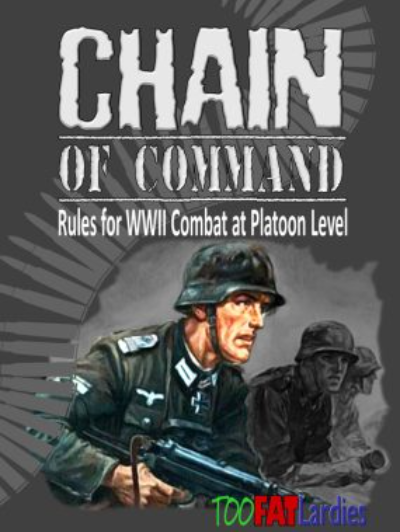A friend of mine, who has an appetite for buying old minis that rivals mine, has introduced me to historical wargaming. Or well, more precisely Chain of Command, by TooFatLardies. Having played mostly Games Workshop games in my past, this is my first entry into the area of historicals which, I must admit, have never had much appeal to me. Why not? – I don’t know, but I have always perceived them as being overly detailed in their gameplay, with volumes of tables and historical technical arguments, like how the temperature and wind conditions affect the time it takes to reload a musket and so on. All in all something I was very biased and prejudiced against.

However, I really enjoy World War II movies such a Saving Private Ryan, The Guns of Navarone and Band of Brothers. Although they are not necessarily historically accurate movies, the movie Fury from 2018 definitely comes into mind here, those movies and series have created a dramatic background, a sort of fictive universe around the war, infused with personal dramas and thrilling adventures, in much the same way as the Old world of Warhammer. So just like the rich lore and background contributes to the excitement of actually playing Warhammer, those WW2 movies and tv-dramas have in fact created, a fantasy-universe with a fantastic lore and a rich adventurous history that helps setting up the story around the games set in World War II.

Play the period, not the rules
The ruleset he introduced me to, was Chain of Command and I will say flat out, it is one of the best set of rules for a wargame I have ever played (yes, I have tried Bolt Action). The rules have a number of core mechanics that are very well thought out and keep the game going in a very fluent set of phases. It is not perfect in the way that there are no unclear rules or grey areas and players will, from time to time, encounter situations not specifically covered by the rules. So how does a periodical game written and published by a small game design studio, turn out to be one of the greatest rule sets, I have come across yet? Well, one of the first lines in the book simply says: “play the period, not the rules“. This sentence is at the core of the rules and it forces players to agree upon what would be the most realistic outcome of a given situation. Now, does this mean that the player who knows most about the history will win all arguments? No, the emphasis should not be on the word “period“, but more on the second part of that sentence “..not the rules.” It means that this game only works if there is an agreement between players, a common ground you could say, about how things work. I myself, being a fan of Hollywood World War 2, I like to add a certain amount of artistic freedom to my games. For instance, if appropriate for the scenario I would allows my Soviet commissar to execute cowardly soldiers, even though that was far from how commissars historically functioned in the red army. Likewise a Tiger tank will most likely show up in my Normandy game, even though historically, Tigers in Normandy ’44 were rarer than hens teeth.

Innovative and fitting rules
I won’t go into the details of the rules here as there are plenty of tutorials and game report videos online, ( Tabletop CP is a great place to start) instead I will just briefly run over the top 3 parts of the rules.
- The Patrol Phase, is a special game turn that you paly out before the game itself begins. The Patrol phase uses markers that you move around the table until they get within 12 inches of enemy patrol markers at which point the lock into place. Once all patrol markers have been locked, their position will determine where your troops can deploy. This means that you never line up across the board facing your opponent exactly 24 inches away like most GW games, but often find yourself having troops in the middle of the board near enemy positions from the start of the game.
- Terrain, it actually matters so much that getting your units into the right piece of terrain like a building or a behind a hedge will win or break the game for you. Terrain can block line of sight and protect your troops against fire, which is very important as a unit being caught in the open can be reduced to a pile of corpses in a single round of shooting.
- Shock, troops don’t necessarily die when they get hit, instead a unit will suffer shock when taking fire from enemy troops instead of loosing men. A unit can suffer a certain amount of shock before it breaks from combat, which means you win by breaking the enemy units and don’t have to keep sluggin it out, until either side has no more models on the table.
- This was meant as a top three, but I just have to add the fact* that this game does not require a lot of models as the core of your force consists of a single platoon of about only 30-40 soldiers. You could paint that in a weekend, right?
* this fact is obviously a lie, as you then have to paint up all the support choices such as tanks, trenches, machinegun teams, medics, anti-tank guns… and at that point you really want a second platoon of 40 men to play Big Chain of Command. But still, it is nothing compared to painting a regimental fantasy army with hundreds of troops.

